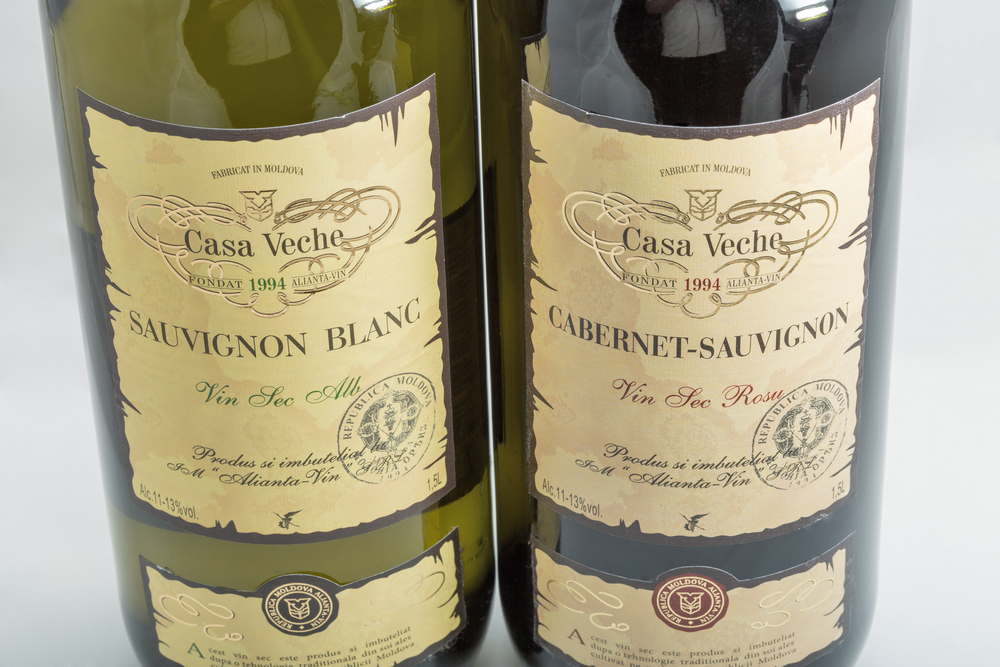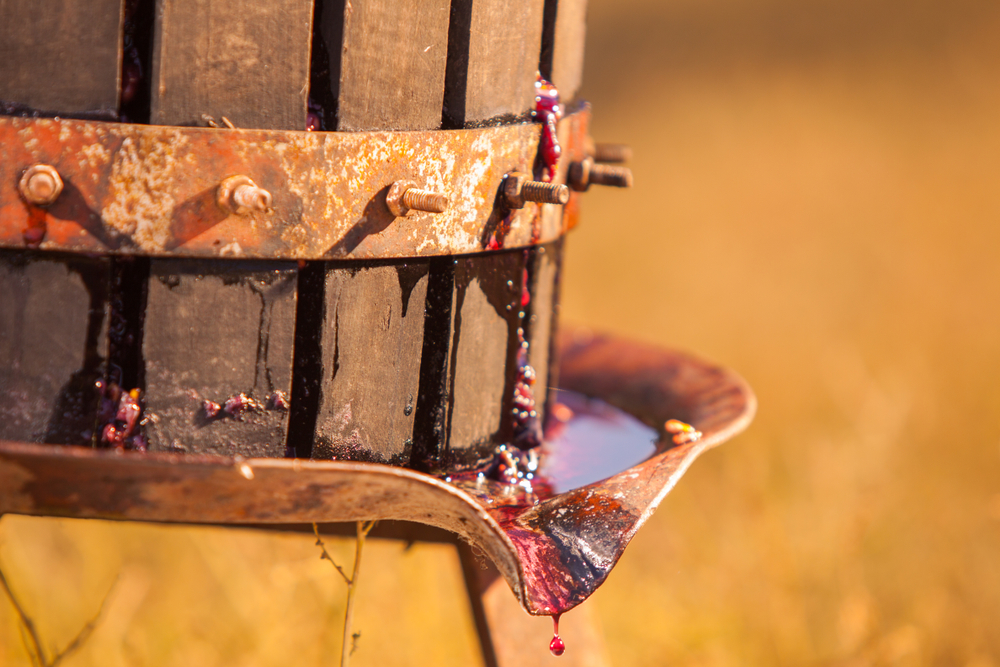When it comes to meat and wine, there are few combinations better than pork chops, and…just about any wine will do, honestly! In addition, pork chops are typically relatively free of fat, meaning that they have a rather tough texture that, when cooked properly, just blends beautifully with wine.
So, if you love pork chops and wine, save this ,study it, memorize it, and share it. Alternatively, check out our guides on pairing ham and pairing pork roast if that’s your preference.
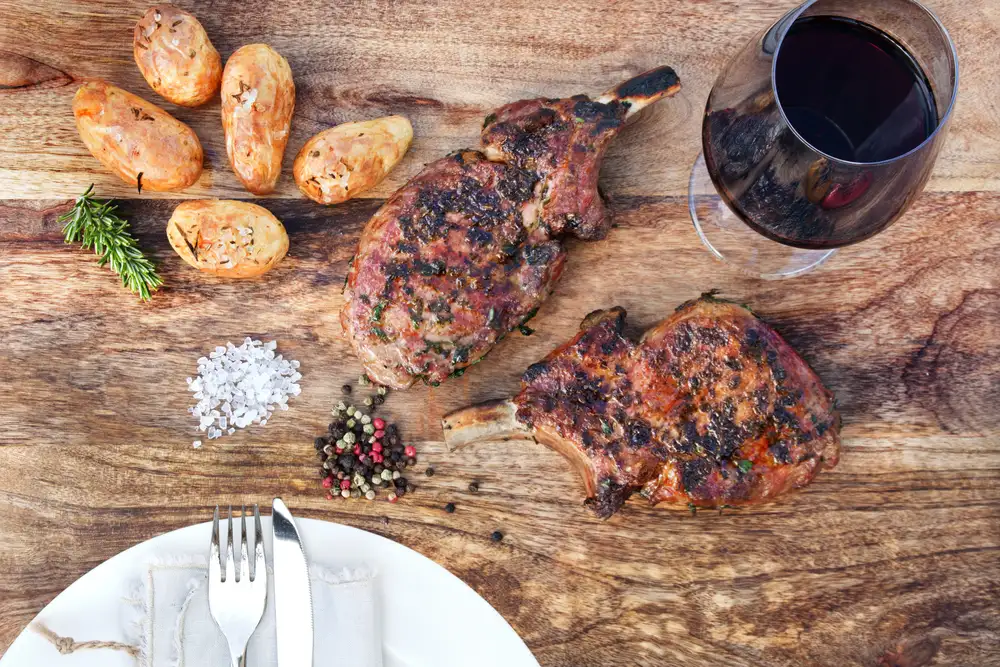
Common Types of Pork Chops
As some people may think, the term “pork chop” doesn’t refer to a single type of meat.
Instead, it refers to many types of pork meat cuts, each of which goes well with different types of wine.
Before discussing how they pair, let’s break down some of the most common and popular pork chops.
You might be surprised at just how many different chops are available: and how differently they can taste!
Shoulder Chop
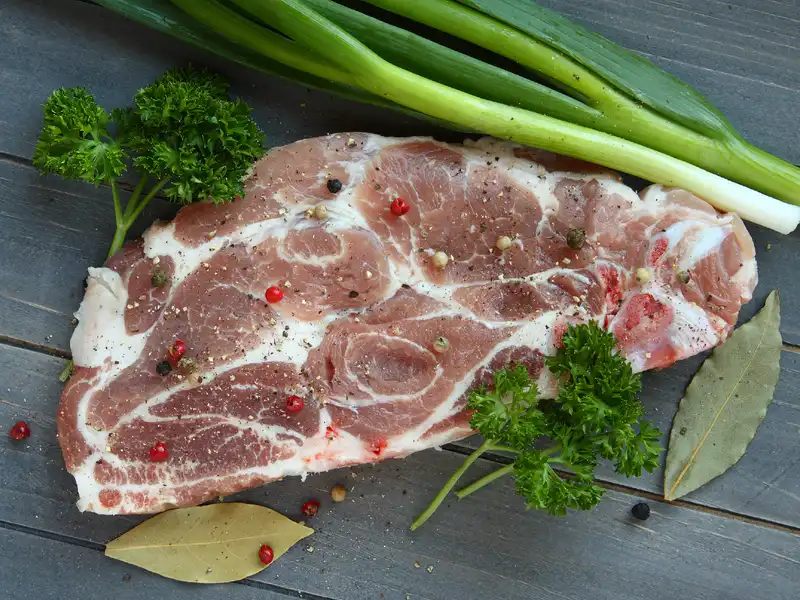
Get a shoulder cut if you want a flavorful but perhaps less healthy pork chop.
Shoulder chops typically contain more fat than other chops and have more connective tissue. That connective tissue gives this cut a rougher texture that a good, long, slow cook can help break apart.
Braised shoulder chops are the best, in our opinion, because they bring out the most taste and counteract some of the toughness inherent in this cut.
We suggest this cut to people who want a smaller meal: shoulder chops aren’t huge but work well as a single-serving meal.
Rib Chop
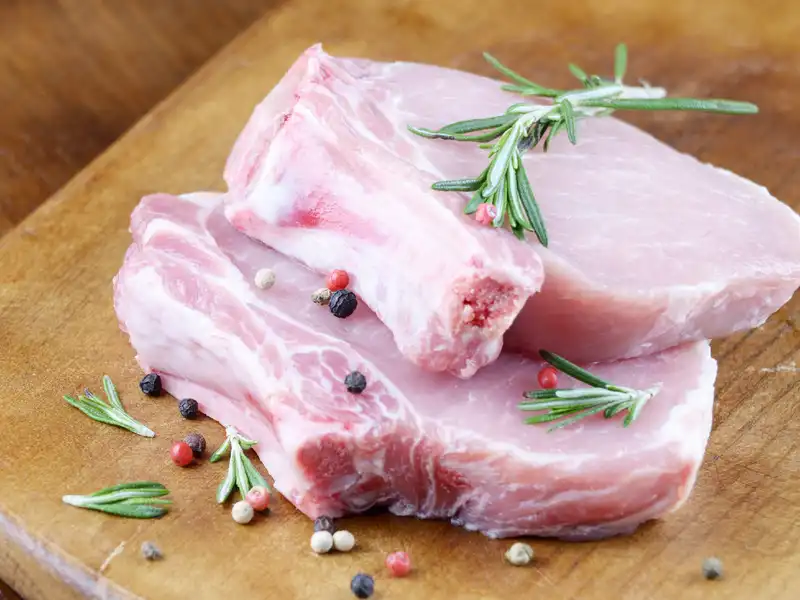
Are pork ribs as good as beef ribs? If you love pork, the answer is “absolutely!” They tend to have a little more fat than other, tougher chops.
That extra fat keeps them well moisturized and minimizes the drying risk familiar with other chops. But, do you know what else that excess fat does? Gives the chop more flavor!
Grilled, broiled, or pan-fried cooking methods typically work the best when preparing a rib chop.
Grilled tends to bring out the meat’s inherent flavor a bit more, while boiled softens it up a little and makes it more palpable. Pan-friend is good in a pinch but may remove some nutrients from the meat.
Related: pairing wine with ribs.
Loin Blade Chop
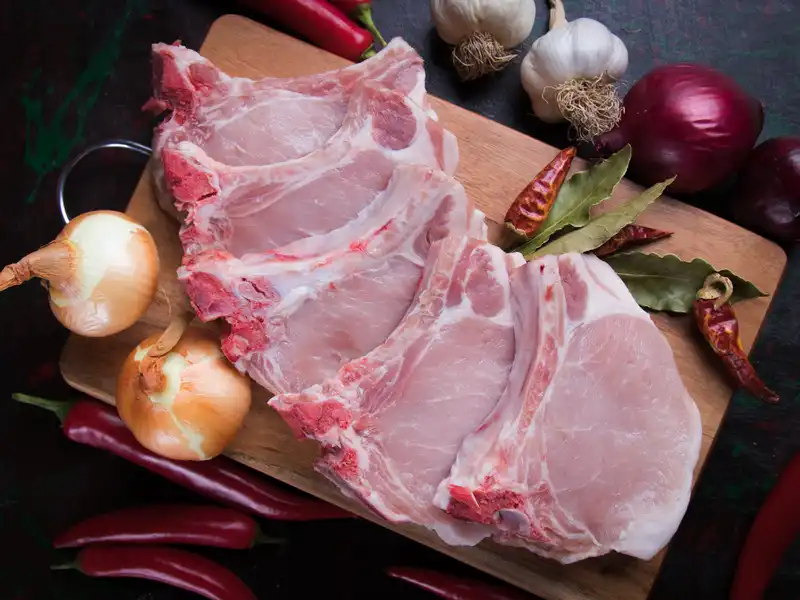
If you’ve ever complained about pork chops being chewy, there’s a good chance you’ve mostly eaten loin blades.
They are typically inexpensive, making them common in low-quality restaurants that probably don’t take the proper steps to prepare this somewhat tough meat.
Thankfully, if you marinate this meat a little and do a slow-cook over several hours, you can improve their tenderness.
Then, the meat’s inherent fat and connective tissue will be easier to eat, and you’ll find them much tastier. This option is suitable for those on a budget who don’t mind working a bit harder to get a great taste.
Loin Sirloin Chop
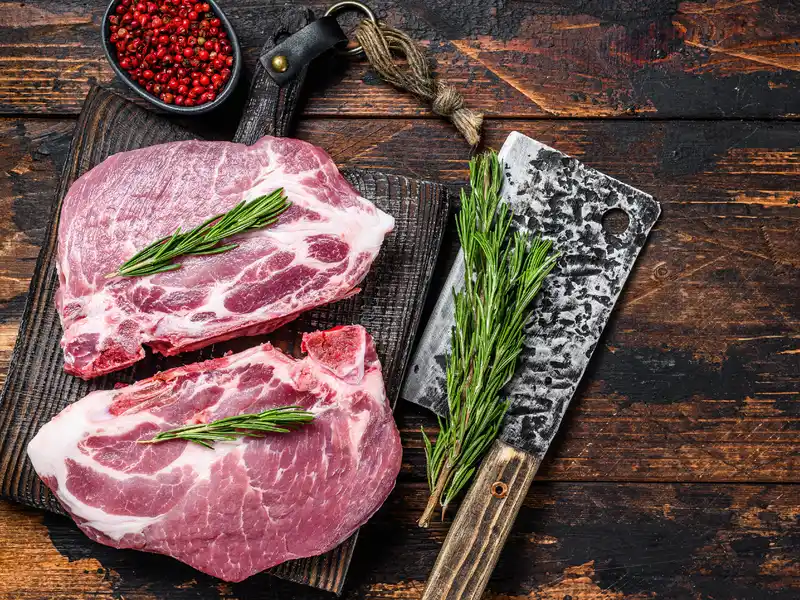
If you don’t mind spending a little money and want a genuinely tender chop, consider this chop! It is naturally lean and tender and provides an excellent taste when cooked properly.
Bad news, though: they do tend to dry more quickly than other cuts, meaning you need to time their cooking just right.
Typically, you want to slow-cook this chop and check it regularly.
When adequately prepared in a slow cooker, you can get meat that falls off the bone. This option is honestly the best choice if you have some money and are a bit patient: you may have to wait a few hours for great results.
Boneless Chop
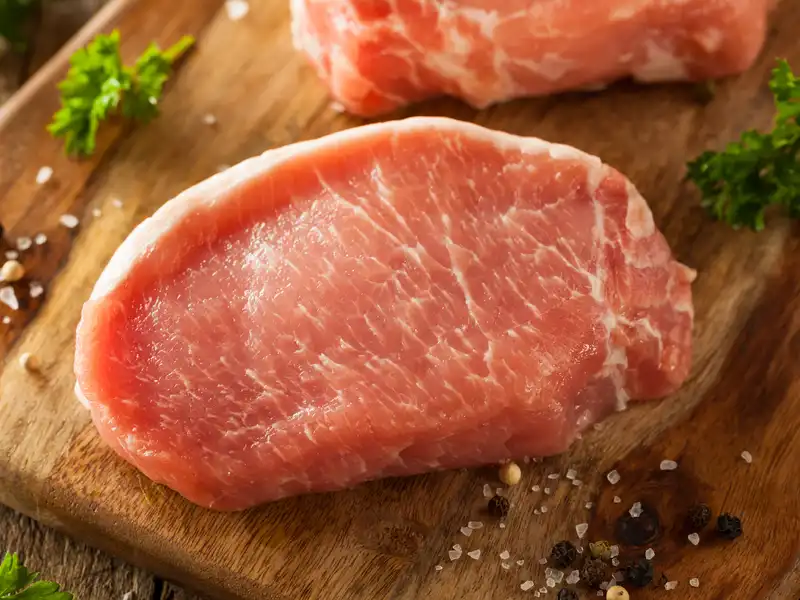
A boneless chop is something you don’t see every day, primarily because they’re a little harder to find.
They require more work to prepare and serve properly, meaning that butchers may not present regularly. However, they have a reasonably lean texture and minimal chewiness.
Thankfully, boneless chops aren’t tough to prepare because they lack the bone to complicate other chop preparation processes.
They’re also reasonably simple to serve and should provide you and your guests with an excellent option for your pork chop and wine pairing night.
How The Pork Chop is Cooked (and Sauce Used) Will Affect the Pairing
Here’s the thing: pork chops don’t necessarily need a lot of complex cooking techniques to come out properly.
However, we strongly suggest that you lightly cook them with a few herbs, such as thyme, that help brings out the meat’s flavor without overpowering it.
You should also choose the best cooking option for your wine pairing, depending on what kind of wines you enjoy.
A pan-fried pork chop typically brings out a sharp pork chop flavor that fruity wines may help counter.
With minimal sauce use, fruity wines help counter any dryness in your pan-fried chops and add undertones of berries, chocolate, and even tobacco that may bring out the best in your chops.
Breaded chops typically retain their flavoring better, particularly when paired with white wines.
Adding sauces makes this process a little more complicated because sauces may overpower your wine and your pork chop.
Typically, I suggest finding a wine variety that compliments, rather than contrasts, with the sauce. In other words, sweet sauces usually go best with sweeter wines, while savory sauces go best with dry wines.
That’s because complimentary tastes enhance the chop’s flavor instead of detracting from it.
While contrasting flavors may work well in many circumstances, with pork chops, you want to bring out the subtle flavors by enriching them with a wine you love.
You can also increase or decrease these taste changes by adding more or less wine to your cooking experience.
Related: You may want to cook your pork chops with red wine, alternatively you can cook with white wines for certain cuts.
Which Wine is Best With Pork Chops?
Is there a specific wine type that goes better with pork chops over all others?
That will likely depend on your taste.
However, several white and red wines work better with pork chops than others. Check out the charts below to get an idea of which red or white wine you want to pair with your pork chops.
Later, we’ll discuss some of these pairings in more depth.
Red Wines With Pork Chops
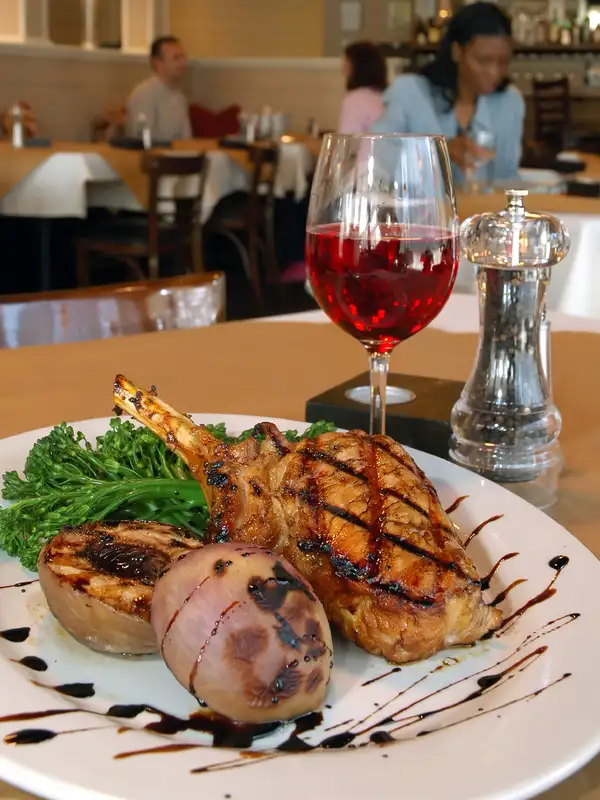
Pork chops tend to pair best with many types of red wines. Though whites often work well, the following reds are perfect for most pork chop types:
- Chiroubles – Beaujolais Cru
- Lagrein
- Pinot Noir
- Zinfandel
- Pinot Noir
- Beaujolais-Villages
White Wines With Pork Chops
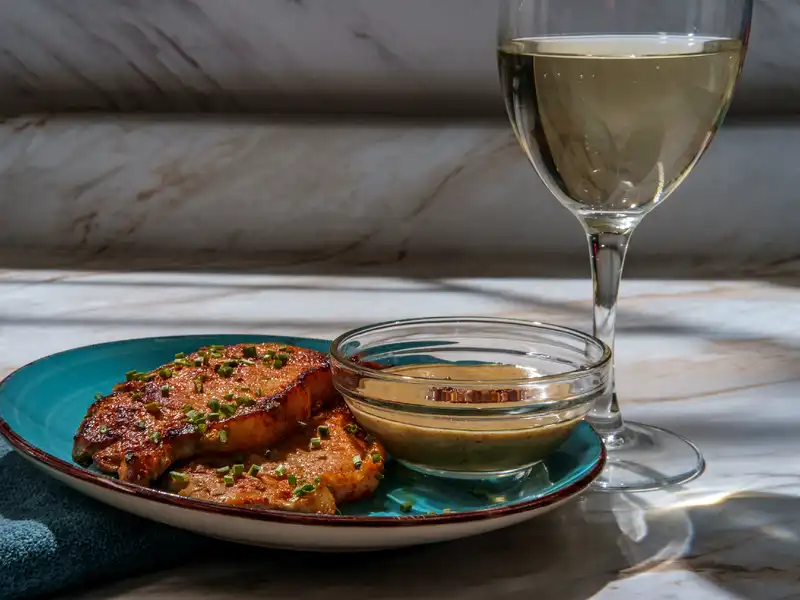
If you love white wines and want to pair them with your pork chops, you’re in luck! While reds may blend better with this meat, these white wines will go well with most pork chop types:
- Savennières
- Chardonnay
- Torrontés
- Pinot Grigio
- Pinot Gris
- Pinot Grigio
Loin Pork Chops and Pinot Noir Pairing
Pinot Noir goes beautifully with loin pork chops because they blend subtle flavors of strawberry and cherry in with your chop.
These pretty sweet flavors help to provide a fine complement and contrast to your pork loin chop. Here’s one instance where just a little contrasting taste may help!
This combination also tends to add a little more acidity to your meal without overpowering you. Generally, acidity is a great thing to add to just about any pork chop meal.
However, I strongly suggest mixing your Pinot Noir directly with your meat and choosing the finest option: don’t buy a cheap Pinot, or you’ll get a bad taste.
Roasted Pork Chops and Pinot Grigio
When you roast pork chops, you tend to dry them out a little.
Why not, as Al Green said, “try a little tenderness” by adding some Pinot Grigio to your pork chops?
Grigo has just the right combination of acidity and subtle aromas and flavors (light and earthy textures) to help balance your roasted chops.
The cool thing about this combination is that it should work with just about any cut we’ve highlighted on this list!
We strongly recommend it for fattier cuts, though, because it may help cut through some of the fatty taste and help bring a little more subtlety to your meat instead.
Pork Chops and Torrontés Pairing
Torrotones may not be on your list of top white wines, but do you know what? It’s one of the best white wines possible for pork chops!
It may be a bit dry compared to some wines, but it has a full body that will add a little flavor to your tender pork chops. Make sure your chops are somewhat tender to get the best results.
If you’re not particular about experimenting with this Argentinian wine, try out my “beginner” approach by dipping your tender chop directly in the wine after cooking.
Then, if you love the taste or think it has potential, marinade your chops with it! You’ll get some great undertones of peaches, lemon, and even coriander.
Grilled Rib Pork Chops and Pinot Gris
Remember what we said earlier about roasted pork chops and Pinot Grigio?
Many of the same facts apply here, too! However, a Pinot Gris is a bit subtler than Grigio, bringing some light acidity and some light and fruity touches to your pork chops that counter the grilled taste.
After all: grilling meat tends to make all meat taste like a grill, doesn’t it?
That’s not necessarily a bad thing (hands up if you love grilled meat!), but marinading your rib pork chops in Pinot Gris before grilling helps add a little more flavor and counters the delicious “burned” taste familiar with grilling.
Rib Pork Chops (plus other fatty chops) and Zinfandel Pairing
Are you preparing some fairly fatty chops, including ribs, from your pork, and do you want something to counter their flavor?
Try a Zinfandel to get great results! Zins don’t have a lot of tannins, meaning that you won’t get an overpowering taste for your chops.
Here’s a tip: mid-priced Zinfandels are your best choice because they don’t have the same kind of overpowering flavor typical to higher-priced options. The light touch of berry and smoke will add a lot to your ribs: they may even taste grilled.
Loin Blade and Beaujolais Pairing
Loin blade pork chops are an interesting chop because they’re relatively inexpensive and a little more challenging.
Adding a Beaujolais marinade may help make this meat better because it adds a little moisture and a touch of taste to your meats. It can also go well with just about any pork chop, though the loin blade often needs this help the most.
This red wine works well as a sauce, as a marinade, or even as a dip for your chops.
Typically, you want to use a nice breading to hold this taste to your loin even better.
You may have difficulty finding a Beaujolais in some regions, so don’t be afraid to go a little cheaper with this option.
Pork Chops and Chardonnay Pairing
Lastly, have you ever had a chardonnay with your pork chops?
Thankfully, they go well with just about any type of chop, and they have a unique taste that I think any pork chop fan will love.
Here’s the trick: if you get a Chardonnay with strong apple notes, you can create that all-time favorite combination, pork chop, and applesauce, without any applesauce.
Here’s another trick that you can consider for just about any wine pairing: you don’t need to spend a lot of money on Chardonnay to get good results.
You typically want a mid-priced option, though, because cheaper options don’t cook as well.
Expensive Chardonnays taste better on the tongue but, when cooking, lose flavor, making the extra cost a bit unnecessary.
- Shrimp Cocktail (and More) Wine Pairing Guide - 09/06/2022
- What Wine Serving Sizes Look Like: Standard Size and More - 08/06/2022
- How Much Sugar is in Wine: Glass and Bottle Sugar Content - 08/06/2022



